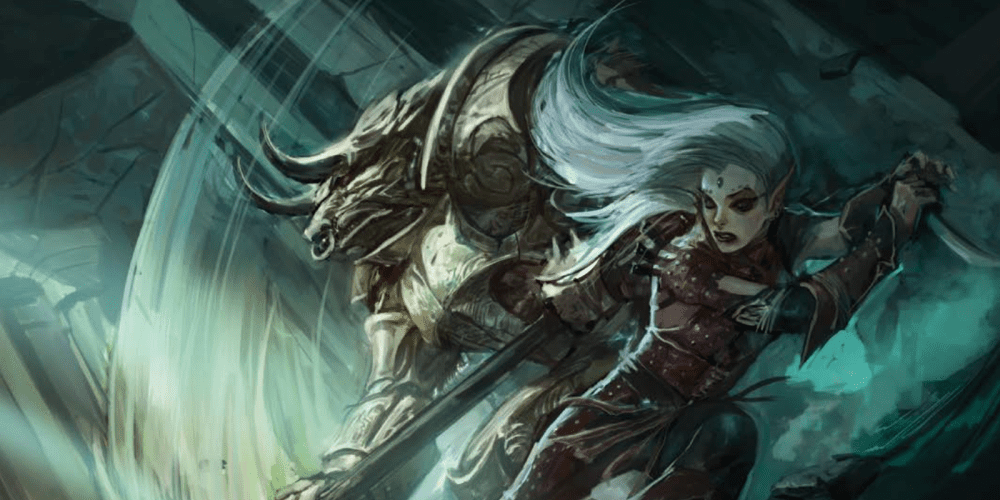Paizo’s “The Emerald Spire” for 5th Edition, Part 5

Late last year, Paizo Kickstarted a superdungeon called “The Emerald Spire“. Along with the characteristicly beautiful production value and stunning art, each of the 16 levels of this detailed module has its own fold-out map in the style of Paizo’s other excellent flip-maps, making it a very easy crawl to run.
I recently decide to host a series of all-day “Retro 80s” Game Days for my players who never had the opportunity to come home from school on Friday afternoons and game non-stop until Sunday night, fueled on little more than Mountain Dew and Cheetos. Since I had backed the Kickstarter at a level where I received all eight double-sided maps as well as the campaign cards, I decided to convert “The Emerald Spire” to 5th edition to use as my old-school dungeon crawl.
The module’s base of operations, Fort Inevitable, requires little conversion as most of the conflicts there are political rather than physical. The dungeon’s levels are designed to equal the PC levels, meaning at 1st level the characters should be able to take on level 1, and by 8th level they should be able to handle level 8. As my players started at level 3, I needed to increase the power of each level a bit.
Below you will find some of my conversions for Level 6, “The Clockwork Maze”. You will not find detailed information on the Emerald Spire. If you aren’t running “The Emerald Spire”, you may still find these new monsters helpful for your home campaign.
Level 1 “The Tower Ruins”
Level 2 “The Cellar”
Level 3 “The Splinterden”
Level 4 “Godhome”: The majority of this level is roleplaying oriented. Should combat break out, the stats for the associated monsters from the 5th ed Monster Manual work well.
Level 5 “The Drowned Level”
Level 6 “The Clockwork Maze”
New Monsters
Modified Minotaur (CR 4)
Clockworker (CR 2)
Human Artificer Alchemist (CR 8)
Optional Creatures
Earlier this year I had the honor of judging Kobold Press‘ Monarch of the Monsters contest alongside two actual RPG luminaries, Wolfgang Baur and Steven Winter. One of my favorite submissions ended up being the winner, the xanka, by Jeremy Hochhalter. I love these critters and had scores of them scuttling around the level. You can find more details and stats for the xanka with our friends over at Kobold!
From the Kobold website:
These small globes of metal have three to six jointed legs which are attached near the base of the sphere of their bodies. Most often, these creatures are formed from copper, brass, or bronze, though gold, silver, and platinum varieties have been seen in the houses of nobles and rich merchants. Designed and given a semblance of life by a gnomish tinkerer, their purpose was to act as clean up for the somewhat messy gnomish enchanters that tended to leave their workshops in a state of littered disarray.
While xanka do not actively seek combat, they are capable of determining if they are threatened by another creature, and will defend themselves.
Xanka do not have language of their own, though they understand commands from intelligent beings speaking the language of the xanka’s creator, most commonly gnomish. However, xanka only obey commands that relate to the removal of garbage. Xanka seem to be able to communicate with one another, though it is not truly understood how this occurs.
When a xanka touches matter with its globe shaped body, it can absorb that matter into itself, and break it down into energy. This way, the gnomes used them to clean up litter and refuse throughout the halls and streets of the city. Xanka are capable of absorbing half their body size in matter per round.
General Conversions
I ran a shortened version of Emerald Spire that focused on the recovery of the missing researchers and concluded the mini-campaign with the exploration of this level. The biggest changes have to do with Room F13, and altering the Pathfinder evoker to a 5th edition artificer alchemist.
In Room F13, I altered the random aghash encounter into something that could either fold into a longer campaign, or be used as a twist at the end.
Jade Automatons
Feel free to use either of the Jade Automatons presented in earlier articles for the ones listed in various rooms.
Room F13
When the PCs reach F11, F14, or F15, and are within a few rounds of entering F13, tell them that they hear screaming, roaring, and explosions coming from the direction of room F13.
This room has 6 sturdy cages of various sizes in the corners and along the walls. The room is filled with steam from the heated fountain as described in the module. The fountain space, as well as the area within 5 feet of the fountain are heavily obscured, while the rest of the room is lightly obscured. There are three destroyed jade automatons scattered throughout the room. The researchers the PCs are looking for are being held in this room (not in F7 as in the original module), as well as any other NPCs you wish that are tied to your campaign.
Laying on the floor next to the fountain is a badly wounded githzerai monk. The monk speaks very broken Common and Gith.
Prisoners: If questioned, the prisoners will tell the PCs that a portal appeared, lighting the fog with a blinding glare. A Large creature came through and a horrible combat ensued between it and the automatons. Between the screeching, arcs of electricity, fog cloud, and violence, it was difficult to make out exactly what happened. Eventually the creature disappeared along with the portal and the automaton guards were destroyed.
Githzerai: If questioned, the githzerai will answer as well as he can in his terrible Common. His name is Grenag and as the prisoners describe the large beast, he will say the word “slaad”. A DC 18 Intelligence (Arcane) check will reveal to the PCs the basics of slaadi physiology and their conflict with the githzerai. Grenag will eventually get across that he was a member of a hunting party tracking the slaad, but he was the only survivor.
What’s Really Happening
Grenag is in actuality the green slaad that came through the portal. He has taken the form of the githzerai in which his own egg hatched. The three automatons inflicted severe damage to him, and though he is regenerating at an impressive rate he knows he isn’t a match for anything else and the portal closed before he could leave. Though he pretends to speak broken Common, he actually speaks Common, Gith, and Slaadi as well as being telepathic. If the players ask questions he is uncomfortable with answering, he will avoid them by either feigning blood loss or acting as if he doesn’t understand the question.
At this point you have a few options:
- Grenag accompanies the PCs, helping them defeat the artificer and traveling with them until he can decipher how to utilize the dimensional properties of the Spire to bring more of his companions.
- Grenag uses the fight with the artificer to turn on the party and destroy them, as well as the artificer, taking over this level of the Spire and bringing his own people.
- The party attacks Grenag out of suspicion. Grenag will defend himself as well as he can. Remember, though he’s faking severe wounds, he will have regenerated himself to full health within a couple of minutes of being discovered by the party.
Modified Minotaur
Large monstrosity, chaotic evil
Armor Class 18 (natural armor, armored plating)
Hit Points 103 (11d10 + 44)
Speed 30ft.
Initiative +0 (+6 if using the alternate Initiative rules)
Str 20(+5) Dex 11 (+0) Con 18 (+4) Int 6 (-2) Wis 16 (+3) Cha 9 (-1)
Vulnerability Lightning
Skills Perception +7
Senses darkvision 60ft., passive Perception 17
Languages Abyssal
Challenge 4
Charge. If the minotaur moves at least 10 feet straight toward a target and then hits it with a gore attack on the same turn, the target takes an extra 9 (2d8) piercing damage. If the target is a creature, it must succeed on a DC 15 Strength saving throw or be pushed up to 10 feet away and knocked prone.
Shocking Charge. Whenever the modified minotaur scores a critical hit with its large greataxe or gore, it deals an additional 9 (2d8) electrical damage.
Labyrinthine Recall. The minotaur can perfectly recall any path it has traveled.
Reckless. At the start of its turn, the minotaur can gain advantage on all melee weapon attack rolls it makes during that turn, but attack rolls against it have advantage until the start of its next turn.
Fortification. If hit with a critical, the modified minotaur has a 50% chance of reducing the attack to a normal hit. This feature does not work against attacks that deal lightning damage.
ACTIONS
Multiattack. The modified minotaur can make two melee attacks per round, once with its great axe and once with a gore.
Large Greataxe. Melee Weapon Attack: +7 to hit, reach 5 ft., one target. Hit: 18 (2d12 + 5) slashing damage.
Gore. Melee Weapon Attack: +7 to hit, reach 5 ft., one target. Hit: 14 (2d8 + 5) piercing damage.
Clockworker
Medium construct, unaligned
Armor Class 18 (natural armor)
Hit Points 33 (6d8 + 6)
Speed 25ft.
Initiative +0 (-4 if using the alternate Initiative rules)
Str 14 (+2) Dex 11 (+0) Con 13 (+1) Int 1 (-5) Wis 3 (-4) Cha 1 (-5)
Damage Immunities poison, psychic
Condition Immunities blinded, charmed, deafened, exhaustion, frightened, paralyzed, petrified, poisoned
Senses blindsight 60ft. (blind beyond this radius), passive Perception 6
Languages Understands Draconic
Challenge 2 (400 XP)
Antimagic Susceptibility. The clockworker is incapacitated while in the area of an antimagic field. If targeted by dispel magic, the clockworker must succeed on a Constitution saving throw against the caster’s spell save DC or fall unconscious for 1 minute.
Minor Repair. Clockworkers are trained in the minor repairs needed to maintain their companions. As an action, the clockwork servant may attempt repairs on any construct within reach, healing 6 (1d10) points of damage. The clockworker may not use this feature on the same target again until the target takes additional damage.
Major Repair. By spending 10 minutes repairing a construct, a clockworker may heal 20 (4d10) hit points of damage to the target and remove one condition affecting the target. A target may not benefit from this feature again until it takes a long rest and additional parts are made available.
ACTIONS
Multiattack. The servant makes two attacks. The servant typically has 2 nets folded and loaded into launchers located on either shoulder. Folding and reloading a chain net requires 1 minute and the assistance of at least 1 other creature.
Slam.Melee Weapon Attack: +4 to hit, reach 5 ft., one target. Hit: 5 (1d6 + 2) bludgeoning damage, plus 5 (1d8) electrical damage.
Chain Net (2/day).Ranged Weapon Attack: +2 to hit, range 20 ft./60 ft., one Large creature, 2 Medium creatures, or 4 Small creatures. All targets must be within 5 ft. of each other. Hit: A Large or smaller creature hit by a chain net is restrained until it is freed. A net has no effect on creatures that are formless, or creatures that are Huge or larger. A creature can use its action to make a DC 18 Strength check, freeing itself or another creature within its reach on a success. Dealing 15 points of magical damage from a slashing weapon or damaging spell (AC 15; no save bonuses; lightning and poison immunity, fire and cold resistance, acid vulnerability) frees all creatures without harming them, ending the effect and destroying the net. If the net is targeted by an attack that deals lightning damage, the net remains unarmed, but the damage is applied to all creatures restrained by or touching the chain net.
In addition to the artificer in room F12, there are 2 jade automatons as presented in earlier articles.
Artificer Alchemist
Medium humanoid (human)
Armor Class 14 (mage armor, ring of protection +1)
Hit Points 62 (10d6+20)
Speed 30’ ft.
Initiative +0 (+2 if using the alternate Initiative rules)
_______
Str 12 (+1) Dex 10 (+0) Con 15 (+2) Int 20 (+5) Wis 10 (+0) Cha 14 (+2)
_______
Saving Throws Str +1, Dex +0, Con +5, Int +8, Wis +0, Cha +2
Skills Arcane +8; Nature +8; Investigation +8
Senses darkvision 60 ft. (darkvision formulae goggles); Passive Perception 10
Languages Draconic, Common, Undercommon
Challenge 8 (3,900xp)
_______
Artificer. The artificer’s formula/spells typically take the form of mechanical and magical devices. For example, his mage armor is a force field generator, his faithful hound is a clockwork mastiff, his familiar is a clockwork spider, and his ability to conjure elementals is a combination of magi-tech gates and his research into the Spire’s interdimensional properties. For fun I gave him a fist-sized clockwork red and white sphere that opened a pocket dimension that held the creatures he “chose”.
Spellcasting. The artificer is an 11th level caster. His spell casting ability is Intelligence. He has the following formula prepared:
Cantrips (at will): acid splash, light, mending, spare the dying, shocking grasp
1st Level (4 slots): cure wounds, mage armor, magic missile, sleep
2nd Level (3 slots): darkvision, shatter
3rd Level (3 slots): counterspell, fly, lightning bolt
4th Level (3 slots): dimension door, Mord faithful hound
5th Level (2 slots): animate objects, conjure elemental, hold monster
6th Level (1 slot): disintegrate
Formula Book
Contains the following alchemical formula: 1st: alarm, comprehend languages, cure wounds, detect magic, expeditious retreat, find familiar, grease, mage armor, magic missile, sleep; 2nd: arcane lock, darkvision, enhance ability (B), find traps, knock, magic weapon, scorching ray (B) shatter; 3rd: counterspell, fly, leomund’s tiny hut, lightning bolt (B), protection from energy, water walk; 4th: dimension door, conjure minor elemental, fabricate, Mord faithful hound, Mord magnificent mansion; 5th: animate objects, conjure elemental, contact other plane, creation, hold monster; 6th: arcane gate, blade barrier, disintegrate, move earth
ACTIONS
Multiattack. Artificer can make two cantrip attacks per round.
Acid Splash (rod attached to a tank on artificer’s belt). DC 16 Dexterity save, range 60 feet, up to 2 targets 5ft. apart, Hit: 12 (3d6) acid damage
Disintegrate (small blaster pistol). DC 16 Dexterity save, range 60 ft., failed save equals 80 (10d6 +40) force damage. No damage on a successful save.
Magic Missile (shoulder device that fires missiles). Autohit, range 120 feet, 3 missiles, Hit: 4 (1d4+1) force damage per missile. +1 additional missile per spell slot above 1st.
Scorching Ray (wrist device that fires rays). +8 to hit, range 120 feet, 3 rays of fire, 9 (2d8) fire damage, +1 ray per spell slot above 2nd.
Shocking Grasp (mechanical glove). +8 to hit, range 5 feet, one target, 15 (3d8) lightning damage, attacks made with advantage against wet targets and targets in metal armor.
Lightning Bolt (small backpack that supercharges mechanical glove). 100 foot long x 5 foot wide line, DC 16 Dexterity save, 32 (8d6) lightning damage (half on successful save). Creatures standing in water or who are submerged make saves with disadvantage. Flying creatures make saves with advantage. +1d6 damage per spell slot above 3rd.
Treasure
ring of protection +1, formula book, scholar’s pack, spire transport token, 4 vials of acid, 4 vials of alchemist fire, wand of magic missiles, 2 potions of greater healing, figurines of wondrous power (golden lions)
Tactics
The artificer has his Mord faithful hound already in the room and will position the creature between himself and any enemies. If able to prepare for an attack, he will conjure an earth elemental to defend himself. The artificer has a clockwork spider he will use to deliver shocking grasp spells as needed, as well as two golden lion figurines of wondrous power.
If reduced to 15 hit points or less, the artificer will attempt to dimension door to the spire room and transport to the surface to escape.



